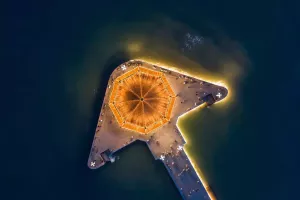In everyone's definition, the sea is inherently blue, just like the sky is blue and the clouds are white, both are products of nature. But if you look closely, you can see that the sea water is colorless and transparent. Why is the sea composed of countless drops of colorless and transparent sea water blue?
In fact, the original color of sea water is not blue, but transparent. The color we usually see is the light that enters our eyes after reflection and scattering of sunlight. Sunlight is composed of seven colors of light: red, orange, yellow, green, cyan, blue, and violet. The wavelengths of the seven colors are different, from red to violet, and the wavelengths gradually become shorter. Among them, red light, orange light and yellow light with long wavelengths have strong penetrating ability and are most easily absorbed by water molecules.
Although some of the light with shorter wavelengths such as blue light and violet light will be absorbed by seawater and sea creatures, most of it is scattered by the seawater to the surroundings, or simply reflected back. This part of the scattered or reflected light enters our eyes later, so the sea in our eyes should be blue and purple. So why are purple seas not common? Because people's eyes are very insensitive to violet light, they often turn a blind eye, but are more sensitive to blue light. As a result, the ocean we see is blue or dark blue.
Many people may have questions, where did the purple light go? This is because human eyes are not sensitive to purple light, so the human brain will automatically ignore purple, which is the most marginal light. In other words, the colors of the sky and the sea are actually the chosen impressions.
The depth of the water in each region affects the color of the water. The water in the ocean, like ordinary water, is pure and colorless. In layman terms, we can compare seawater to a glass of water in a glass. When there is less water in the glass, light can easily pass through the glass, and the water in the glass will take on a transparent color. But if the cup is very high and the water in the cup is very deep, then the light will make the water in the cup appear blue under the action of various factors. This is because ordinary sunlight appears colorless, but actually contains seven different colors. The blue part of these colors has a short wavelength band, so it cannot penetrate a long distance, and can only be scattered and reflected on the surface of the seawater.
It is estimated that everyone has heard of the Red Sea, the Black Sea, etc. In fact, the sea water is not only blue, because the substances contained in the sea water in each region are different, which will also affect its color change.
1. Red Sea: The "Red Sea" between the Asian and African continents is red because the water temperature there is extremely high, and many reddish-brown seaweeds grow.
2. Black Sea: Because the strait is narrow and the salt content at the bottom is high, the waters of the Black Sea are not flowing smoothly, so the bottom layer is in an oxygen-deficient state, resulting in a large amount of biological waste and decaying plants that cannot be discharged, thus turning black.
3. Pink Sea: This is caused by red tide, the pink noctilucent red tide turns the sea pink.


